Birthplace of Niagara
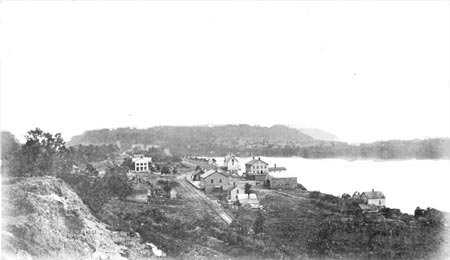
The Niagara River is the west border of the village seen in this 1890’s view. The Seneca Indians called it “Ongiara” or neck. The Neuter and the Iroquois Indians had older forms of the name. Peter Porter wrote the best interpretation for Ongiara is “the thunder of the waters.” The French called it the “Niagara.” It connects Lakes Erie and Ontario.
Lewiston is historically significant for many reasons, but primarily for:
- Its geography and its relation to Niagara Falls in the early commercial development of the Great Lakes region.
- Its role in the War of 1812, and
- Its position as the last stop of the Underground Railroad for escaping slaves who were seeking freedom in Canada.
Lewiston was the birthplace of the world famous Niagara Falls about 12,000 years ago, near the present location of Artpark. Since then, the power of Niagara Falls has eroded south through seven miles of solid rock. You can see the path the Falls has taken by following the Niagara Gorge which begins in Lewiston.
Early French and British Explorers and Traders
Lewiston was the first European settlement in Western New York. During the 1600s and 1700s, when the French and British traders settled in the area, Lewiston was instrumental in the development of the Great Lakes region because of its strategic location.
The first French explorer, Etienne Brule arrived in 1615. By then, the Five Nation Indian Alliance had been established since 1450 and each of the tribes — Mohawk, Seneca, Onondaga, Oneida and Cayuga — had its designated duties. The Senecas were the protectors of the land and waterway rights of the Niagara River, Lake Erie and Ontario. The Senecas were the “Keepers of the Western Door.”

Lewiston District School No. 1 was located at the southeast corner of Cayuga and Sixth Streets. The school was closed in the early 1900’s and then used as an evaporator for drying apples. It was destroyed by fire.
Father Louis Hennepin, who was accompanying the French explorer Sieur LaSalle, landed in Lewiston in December 6, 1678. LaSalle was searching for the Mississippi River. The next day, the Senecas escorted Fr. Hennepin to see Niagara Falls, which made such an impression on the priest that he wrote a glowing report. He was the first European to write about seeing the Falls. (When Fr. Hennepin saw the Falls he witnessed twice the water going over the falls as is seen today. In the past decades, half of the natural flow water has been diverted to hydroelectric power plants in both Canada and the United States.)
Later, the explorers built a small chapel and a fortified cabin in which to store their supplies, much of which was used to construct the first ship on the Great Lakes, The Griffon, which was built and launched on the Niagara River above the falls.
The first permanent structure built by a white man in Western New York was in Lewiston in 1720. It was built by Frenchman Chabert Joncaire. The trading post, officially known as Le Magazin Royal, was constructed after he received permission from the Seneca Indians. It was located on the site of today’s Artpark “painted parking lot” which is located immediately east of the main theater. Le Magazin Royal is no longer standing, but ruins that were studied in the 1950s indicated that it was destroyed by fire in 1741. You can get more detailed information about Le Magazin Royal here.
Because Niagara Falls created an insurmountable obstacle for shipping good and materials by water, a transportation route or detour around the Falls had to be created. The land route around the Falls was called the “portage,” and Lewiston was the major drop off point for shipped goods and materials that were transported on the portage.
The French held the land and maintained the trading post and employed the Indians to transport goods from Lewiston to the upper Niagara River at a place upstream from the falls where the river was again safely navigable. Back in those days Lewiston was called “the carrying place.” As trade increased, fur pelts came from the west in great quantities and from the east came the supplies for the military posts and trading stations. The Trading Post and the portage, which provided a bypass around Niagara Falls for goods to be transported, opened up commerce on the Great Lakes for the first time.
In 1998, the The National Park Service declared this location a National Historical Landmark and erected a plaque which states:
“Lower Landing Archeological District has been designated a National Historic Landmark. This site possesses national significance in commemorating the history of the United States of America. The archeological remains of Joncaire’s trading post (1719-1741) and other archeological resources document inter-cultural relations at this key point within the colonial Niagara historic district.”
In 1754, French soldiers cut the first narrow road from the Niagara River landing to the top of the Niagara Escarpment to accommodate the increase in the amount of goods being transported over the portage. A series of capstans and booms were installed to help the oxen pull the wagons up the steep zigzag road of the Escarpment and to slow their descent.
In 1757, the Senecas complained to the French Governor that their rights of control of the portage and their privileges were being violated. But the French were not going to have in influence in the area for long.
In 1763, at the conclusion of the French and Indian Wars, the British controlled North America and the portage. The British improved the road and built several stockades along the route where troops were stationed for the protection of the wagon trains. Capt. Montresor of the Royal Engineers, began to construct a which, by some accounts, is considered the first railway in North America. The cars were counterbalanced for easier operation up the steep incline from the river.
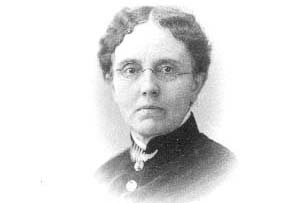
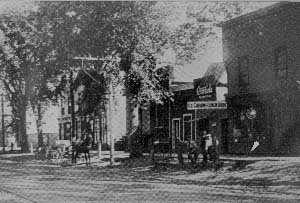
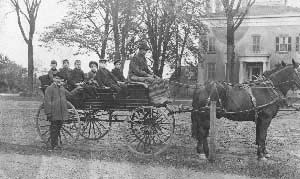
Dr. Dewitt Wilcox is standing adjacent to the wagon in 1902. Hennepin Hall on the northwest side of Center and 7th Streets has been a home, a restaurant, a school, and presently the rectory for St. Peter’s Catholic Church.
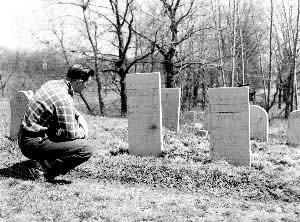
Many of Lewiston’s early settlers are buried in the Lewiston Cemetery, located next to the Presbyterian Church. Among them are Catherine and Thomas Hustler whose grave stones can be seen here. Thomas died in 1822, aged 68 years, while Catherine died ten years later at the age of 70. The Hustlers were used as the models for Betty Flanigan and Sergeant Hollister by author James Fenimore Cooper when he wrote the The Spy. According to Cooper, it was Catherine Hustler who invented the “cocktail.” She said, “It warms both the body and soul, and is fit to be put in a vessel of diamonds.” The wording on Catherine’s gravestone is hard to read, but with patience you can decipher:
“Traveler, as you are passing by —
As you are now, so once was I —
As I am now, so you must be,
Prepare for death and follow me.”
Devil’s Hole Massacre
The Senecas lost their control of the portage and their main means of livelihood and were upset. On September 14, 1763, the Senecas ambushed a wagon train that was transporting goods along the portage. After killing and scalping dozens of the troops accompanying the wagon train, the Indians drove the oxen and carts over the cliff to destruction on the rocks far below. Another contingent of soldiers sent to their aid was also ambushed and murdered. Only two men and a drummer boy from the wagon train, and a few from the relief column, lived to tell of the terrible massacre at the place on the river road known as “Devil’s Hole,” which is now a state park situated about 2 miles south of the Village of Lewiston. Some historians call the Devil’s Hole Massacre the first labor uprising in North America, though it is generally understood that the violence was caused by greater forces at play, primarily Pontiac’s Rebellion.
The British did not retaliate against the Senecas. However, a subsequent council meeting between the British and the Six Nation League after the incident, resulted in the Senecas being required to deed a strip of land a mile wide along each side of the river to the British. This land became known as the Mile Reserve.
In 1775, Joseph Brant, the war chief of the Mohawk tribe and a Loyalist, settled with his tribe along Ridge Road (Route 104). He built his home and a chapel at the intersection of Ridge and Creek Roads. A church bell, received by the Mohawks from Queen Anne in 1712, hung in a tree nearby. The Queen had also presented the tribe with a sterling silver Communion Service which had been buried for safekeeping during the Revolutionary War. Today, Brant’s Spring is the smallest “park” or reservation in the United States.
In 1784, Rev. John Stuart, a Church of England priest, visited Brant and returned to him the Communion Service.
During and after the Revolutionary War, many United Empire Loyalists from the Eastern states came to Lewiston to cross the river to Queenston in Canada. At the instruction of Gov. Simcoe of Upper Canada, a ferry service was started between Lewiston and Queenston in 1791. So great was the traffic waiting to cross the river that wagons were reported to be lined up for three miles. In 1796 there were still only a few Indian and Loyalist squatters as permanent residents in Lewiston. The Senecas still claimed ownership title to the Mile Reserve land along the river. Without clear title, the land could not be sold and except for the few squatters, people wanting to settle moved on.
Lewiston is Named and Surveyed
The Jay Treaty of 1796 between Britain and the United States set the border between the two countries midway across the Niagara River. The land titles were cleared to the dismay of the Senecas. None of their land claims were considered valid. The Indian and Loyalist squatters were given land grants in Canada.
Chief Joseph Brant moved his people to the Six Nations Indian reserve in Brantford, Ontario. The 1712 Queen Anne Communion Service is still in safekeeping at the Anglican Church on the reserve.
In a transaction known as the “Holland Land Purchase,” Robert Morris bought from the State of New York three million acres of land extending east from the Niagara River. By 1798, New York State surveyors began the work of surveying and dividing the Mile Reserve.
The site for a mile square village was chosen and named Lewis Town in honor of the Governor, Morgan Lewis. The survey of the streets and building lots was completed by 1805. The original plan extended east from the shore for ten blocks, numbered from one through nine. The cross streets were named for the Six Nations Indians — Onondaga, Oneida, and Mohawk to the north of Center Street and Cayuga, Seneca and Tuscarora to the south. A large town common area was reserved between Fourth and Seventh Streets and Cayuga and Onondaga Streets. This area contained most of the high land in the village. In 1810, the State Legislature granted the petition of the Village requesting the division of this land for building lots. Plain and Ridge Streets were added to the street plan. However it was 1815 before these lots were available for sale.
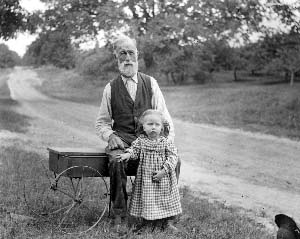


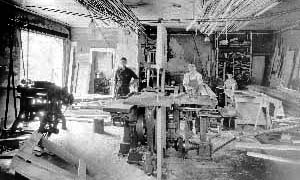
The Vevirit Lumber Company was a family business opened in 1921 on South Eighth Street. The family also operated a hardware store in the Hochkiss Building at 479 Center Street which is a real estate office today.
The First Major Battle of the War of 1812
On October 13, 1812, the United States invaded Canada. Lewiston was the staging area for the Battle of Queenston Heights, the first major battle of the War of 1812. Cannons installed on the lawn of Barton Hill were aimed at the village of Queenston, across the Niagara River in Canada. Troops were quartered on Major Barton’s property as well.
Americans lost the battle primarily because the local militia refused to fight on foreign soil, stating their job was to defend the United States, not invade Canada. Losing American General Stephen VanRensselaer explains how the battle was lost in a letter to Maj. General Dearborn. However, regular American soldiers did cross the Niagara River to Canada and killed General Brock, the British commander, near the base of Queenston Heights in the early morning hours. Brock was an admired and respected leader and his tall monument stands in Queenston today and can be seen across the river from Lewiston. Many Canadians believe that if it wasn’t for General Brock’s leadership, that Canada would not be an independent country today, but rather part of the United States.
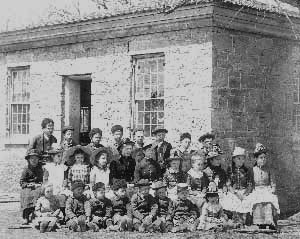
On January 18, 1842 a vote was taken to build this stone schoolhouse which became known as Hickory College located on the north side of Ridge Road. It was also used for Sabbath School and political meetings. Today it is part of St. Jude’s Shrine.
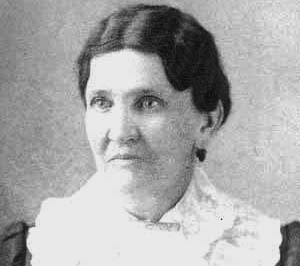
Miss H. A. Vosburgh was an early primary school teacher.
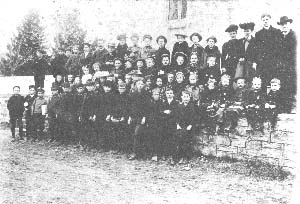
This 1902 photo was taken adjacent to the First Presbyterian Church. The church was organized in 1817. Robert Nichols, a stone mason, laid the cornerstone in 1830.
Lewiston Attacked, Dozens of Citizens Saved by “Tuscarora Heroes”
In early December of 1813, General McClure, the American General, ordered that the occupied town of Newark, then the capital of Upper Canada (now Niagara-on-the-Lake) and Fort George be burned. The residents, mostly women and children, who were ordered to leave the town before it was burned, were left homeless during a bitter cold winter. The able bodied men had joined the British troops who had retreated to Burlington when the town was captured.
Retaliation was swift and savage. In the early morning (near daybreak) on December 19, 1813, the citizens of Lewiston awoke to unimaginable horrors. Hours earlier, in the middle of the night, British-Canadian troops invaded the United States and captured Fort Niagara without firing a shot. And now, they were about to unleash an assault on Lewiston that could only be compared to today’s “shock and awe” campaigns.
The unrestrained British-Canadians, along with their allies from the First Nations, including the Mohawks, ran down River Road toward Lewiston, armed with torches, guns and tomahawks — intent on retribution and turning Lewiston into a pile of ashes.
But what happened that cold winter morning turned out to be much worse. Poorly defended, Lewiston citizens were on their own. They could only run for their lives through the snow and mud in hopes of escaping the atrocities. Civilians were murdered in the rampage and tormented parents found themselves helpless in trying to save their children — one 7-year-old was shot and scalped in front of his mother’s eyes.
At the moment when Lewiston citizens had lost all hope and thought they would all become victims of a bloody and merciless massacre, Native Americans from the the local Tuscarora village ran down from atop the Escarpment and offered the first resistance the British and Mohawks had seen. The Tuscarora’s ingenious and diversionary tactics gave the impression that their “numbers were legion.” Fearing a trap, the enemy stopped in its tracks.
Despite being outnumbered 30-to-1, the “Tuscarora Heroes” were able to buy the escaping residents enough time to get out of harm’s way, and saved the lives of dozens of citizens.
Meanwhile, Lewiston was burned the ground, except for one building. The exact number of civilians who were killed is unknown. Estimates range from close to a dozen to over 40. One American officer, reported soon after the attack, that “it is not yet ascertained how many were killed as most of the bodies were thrown into the burning houses and consumed.”
The Historical Association of Lewiston (716-754-4214) has just published a book, Tuscarora Heroes, which details the attack and lists all of the names of the Tuscarora men who participated. The Association is planning to unveil a Monument of thanksgiving to the Tuscarora Nation on Dec. 19, 2013, on the 200th Anniversary of the attack.
The British remained in control of Fort Niagara and the area until the end of the War of 1812. Small war parties from Fort Niagara continued to attack and harass the few remaining inhabitants on several occasions. The Fort was returned to the Americans in 1815 and peace returned to the area.
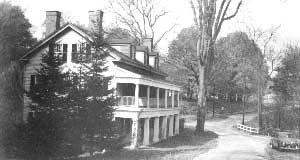
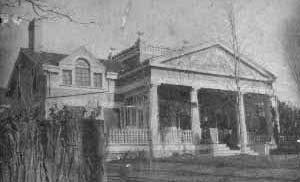
The Barton House, located at Center and Third Streets is a village favorite. The first house was destroyed in the War of 1812. Maj. Benjamin Barton used the wood from a willow tree for framing lumber of the house. The stump of the tree is in the left foreground of the image. It remains a private residence.
The Invention of the “Cocktail”
Hustler’s Tavern in Lewiston was reportedly the only building left unscathed when the British invaded. Some say it was because the British officers remembered too many good times they had there sipping a “cocktail” — the drink that owner Catherine Hustler is credited with inventing when she stirred a “gin mixture” with the tail feather of a stuffed cockerel (a young male of the domestic fowl.) She said it “warms both soul and body and is fit to be put in a vessel of diamonds.”
The Hustlers entertained author James Fenimore Cooper during the summer of 1821 and he was so amused that he included them in his book, The Spy, as characters Sergeant Hollister and Betty Flanigan. Hustler’s Tavern is no longer standing, but the site was located at 800 Center Street (northeast corner of 8th and Center Streets).
Gradually, after the burning of Lewiston in 1813, the villagers in Lewiston began to return to start the slow process of rebuilding their lives, homes and businesses. Before 1825 and the opening of the Erie Canal, Lewiston was called the Gateway to the West and had more population than the City of Buffalo. It was the social center of the Niagara Frontier and saw much stage coach activity. It was home to the finest hotel in the United States west of Albany, which still stands today and is known as the Frontier House which was built in 1824-5 by Joshua Fairbanks, Benjamin Barton and son, Samuel.
The Frontier House is Lewiston’s premiere historic landmark. Stage coaches once thundered up to its doors at a time when Lewiston was the center of the “Great Overland Route Across the Continent.” The Froniter House is constructed of stone from the Bay of Quinte at the Northeastern end of Lake Ontario. 18 men worked 18 months in laying up the solid stone 30 inch walls.
In 1826, William Morgan, the Masonic traitor, was brought here by stagecoach. He changed coaches and continued from here to Ft. Niagara. The original coach he arrived in remained for years behind at the Frontier House because people feared to move it, lest they be implicated in the abduction plot of Morgan. The coach decayed where it came to rest and no trace of it remains today. Historic guests at the Frontier House include: Gov. DeWitt Clinton; Edward, Prince of Wales, James Fenimore Cooper, Charles Dickens, Jenny Lind, Henry Clay and John L. Sullivan. The last use of the building was an historic McDonald’s Restaurant, but at present, it stands empty.

There were a number of rural schools in the town of Lewiston. This was District No. Twelve taken in November 1891.
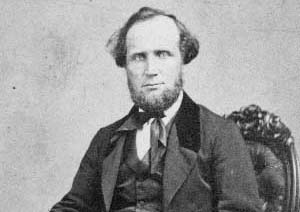
Cooke was an early surname associated with Lewiston. This is an image of Rev. Joshua Cooke. Cooke wrote in 1902 that his grandfather built a pioneer home on the site of Joncaire’s structure in 1802. Bates and Lathrop Cooke were part of the Lewiston Railroad Company, which connected with the Lockport and Niagara Falls Railroad in 1835. Others were Jacob Townsend, Oliver Grace, Leonard Shepard, Joshua Fairbanks, Calvin Hotchkiss, Amos Tryon, Seymour Scovell, and Benjamin Barton.
Underground Railroad & Freedom Crossing
In the early to mid-1800s, Lewiston was the final stop for escaping slaves from the South, seeking freedom in Canada. They called it the Underground Railroad, even though it wasn’t a railroad. Lewiston’s citizens were staunch supporters of the anti-slavery movement and many of them volunteered to help smuggle thousands of slaves across the border. There was a code of silence and Lewistonians never trusted or spoke to outsiders about their secret activities. Lewiston’s “station master” was Josiah Tryon, a local tailor. He and his fellow citizens, hid and guided slaves at the First Presbyterian Church at 5th and Cayuga Streets, the Episcopal Church at 465 Plain Street (now the Lewiston Museum) and at a home on the river called “the house of the four cellars.” Josiah used a row boat countless times to take his precious cargo across the swift river’s currents.
A now famous book was written about Lewiston’s role in the Underground Railroad, called Freedom Crossing, by Margaret Goff Clark, and is read by thousands of grade school students across the United States every year. The Freedom Crossing Monument commemorates the Underground Railroad movement in Lewiston and was dedicated on October 14, 2009.
Today’s Historic Lewiston
Many of the homes and buildings constructed in the 1800s still stand proudly in Lewiston, which has cherished its history. More recently, Lewiston has become known as a charming and quaint village that enjoys hosting visitors from far and wide. The local area is home to many restaurants and small businesses, and institutions such as Artpark are renowned for their theatrical and artistic venues.
A number of festivals and events sponsored by the local arts council, business organization and historical association attracts tens of thousands of annual visitors. Sports fishing is also gaining dramatically in popularity.
The Town of Lewiston is home to the New York Power Authority’s Robert Moses Power Project, which is the largest hydroelectric generating facility in New York State, built in the early 1960s.
Niagara University, founded in 1856, is one of the largest private colleges in Western New York also calls Lewiston home.
The Tuscarora Indian Reservation, established around 1800, is located entirely within Lewiston.
Lewiston continues to evolve as a commercial, cultural, recreational and residential center. Building upon its deep historical roots, development progresses to the make the Niagara River waterfront more attractive and accessible. A new luxury hotel has opened near the foot of Center Street.
Local citizens and visitors alike enjoy the rich and fascinating history, and look to the future with optimism and confidence as Lewiston’s reputation becomes stronger as the ideal place to live, work and raise a family in Western New York.
Much of this material was from Lewiston: A Self-Guided Tour; by Barbara I. Hill, Janet M. Domzella, Kenneth Tracey; published by Friends of the Lewiston Library, Inc. 1986
